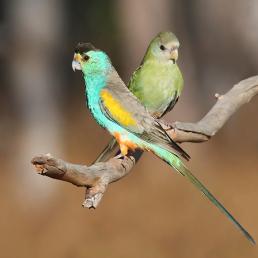

Join BirdNote tomorrow, November 30th!
Illustrator David Sibley and actor H. Jon Benjamin will face off in the bird illustration battle of the century during BirdNote's Year-end Celebration and Auction!
Some plants have evolved fruits with edible flesh that attract birds. When birds swallow the fruit, they also ingest the seeds. They transport the seeds to new spots for the plants to take root. Birds’ digestive systems grind away the hard outer coating of the seed, making it more likely to germinate. Seeds in a bird’s droppings are pre-packaged in nutrient-rich fertilizer.
BirdNote®
Birds, Berries and Germination
Written by Bob Sundstrom
This is BirdNote.
[Hermit Thrush, ML 100856, 0:06-0:12]
When birds swallow berries, they also ingest the seeds within the pulp. After just half an hour or so, they dispose of the seed by passing it through their digestive system or regurgitating it. Either way, the hard seeds wind up on the ground.
There’s an evolutionary reason for this. Plants that evolved fruits with edible flesh could attract birds to eat them. Then, the birds transport the hard seeds within the soft fruits to new spots for them to take root.
[Townsend’s Solitaire, ML 50193, 0:06-0:10]
But birds do more than just carry the seeds. Their digestive system, including their muscular gizzard, grinds away the hard outer coating on seeds, making them more likely to germinate once the birds deposit them.
What’s more, seeds in a bird’s droppings are pre-packaged in nutrient-rich fertilizer when they hit the soil.
[Gray Catbird, ML 107426, 0:28-0:33]
Birds disperse seeds for more than 300 trees, bushes and vines in North America. The benefits are mutual: a fruit-eating bird sows more fruit-bearing plants, leading to more fruit for birds to reap in the future. It’s a relationship developed over millennia of coevolution.
[Townsend’s Solitaire, ML 50193, 0:06-0:10]
For BirdNote, I’m Michael Stein.
###
Senior Producer: John Kessler
Content Director: Allison Wilson
Producer: Mark Bramhill
Associate Producer: Ellen Blackstone
Managing Producer: Conor Gearin
Bird sounds provided by The Macaulay Library of Natural Sounds at the Cornell Lab of Ornithology, Ithaca, New York. Hermit Thrush ML 100856 recorded by W. Hershberger, Townsend’s Solitaire ML 50193 recorded by G. Keller, Gray Catbird ML 107426 recorded by W. Hershberger.
BirdNote’s theme was composed and played by Nancy Rumbel and John Kessler.
© 2022 BirdNote January 2022 Narrator: Michael Stein
ID# eating-02-2022-01-05 eating-02
references:
https://besjournals.onlinelibrary.wiley.com/doi/10.1046/j.0269-8463.200…
https://www.google.com/amp/s/donnallong.com/relationship-between-birds-…
https://www.ncbi.nlm.nih.gov/pmc/articles/PMC6368004/
https://www.birdnote.org/listen/shows/fruit-bribe
https://www.google.com/amp/s/www.birdwatchingdaily.com/news/science/why…
https://www.oneearth.org/how-birds-shape-the-landscape/



